The Agricultural Pheromones Market is estimated to be valued at USD 4.8 billion in 2025 and is projected to reach USD 20.8 billion by 2035, registering a compound annual growth rate (CAGR) of 15.9% over the forecast period. A Peak-to-Trough Analysis reveals key phases of acceleration and deceleration in market growth. Between 2025 and 2030, the market increases from USD 4.8 billion to USD 9.9 billion, contributing USD 5.1 billion in growth, with a CAGR of 15.3%. This phase shows strong acceleration, driven by the rising adoption of pheromones for pest control as the agricultural sector increasingly seeks sustainable, eco-friendly alternatives to chemical pesticides. The first peak occurs at USD 9.9 billion in 2030, followed by a slight deceleration between 2030 and 2032, where the market grows from USD 9.9 billion to USD 11.5 billion, representing a USD 1.6 billion increase. This period sees a slowdown as the market stabilizes after the initial surge in adoption.
From 2032 to 2035, the market accelerates again, expanding from USD 11.5 billion to USD 20.8 billion, contributing USD 9.3 billion in growth, with a CAGR of 19.4%. This rebound is driven by continued innovation, expanding applications, and a broader adoption of pheromone-based solutions, especially in large-scale commercial farming. The Peak-to-Trough Analysis shows an initial acceleration, followed by a brief stabilization, and a strong final surge in demand.
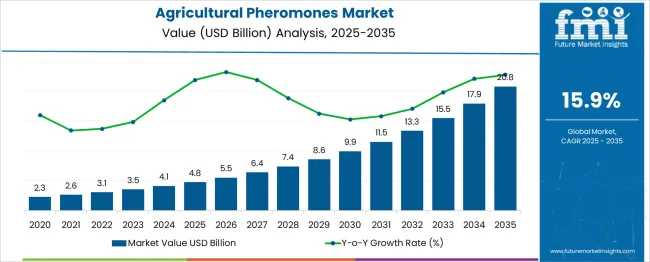
| Metric | Value |
|---|---|
| Agricultural Pheromones Market Estimated Value in (2025 E) | USD 4.8 billion |
| Agricultural Pheromones Market Forecast Value in (2035 F) | USD 20.8 billion |
| Forecast CAGR (2025 to 2035) | 15.9% |
The Agricultural Pheromones market is progressing steadily, supported by increasing concerns around sustainable pest control and integrated pest management practices. A growing shift away from chemical pesticides, driven by environmental regulations and rising consumer preference for organic produce, has contributed to the rising adoption of pheromone-based solutions.
These products offer species-specific control, minimizing harm to beneficial insects and biodiversity. The market outlook remains positive as agricultural productivity is increasingly being aligned with ecological stewardship and climate-resilient practices.
Continuous innovation in semiochemical formulations, improved delivery mechanisms, and government incentives for bio-rational products are further strengthening market potential. With expanding applications in commercial farming and horticulture, agricultural pheromones are expected to become an integral part of next-generation crop protection strategies across both developed and emerging economies..
The agricultural pheromones market is segmented by type, mode of action, end use, and geographic regions. The agricultural pheromones market is divided into Sex pheromones, Aggregation pheromones, Alarm pheromones, Trail pheromones, and Others. In terms of mode of action, the agricultural pheromones market is classified into Mating disruption, Mass trapping, Attract-and-kill, Monitoring and detection, and Others. Based on end use, the agricultural pheromones market is segmented into Horticulture, Field Crops, and Others. Regionally, the agricultural pheromones industry is classified into North America, Latin America, Western Europe, Eastern Europe, Balkan & Baltic Countries, Russia & Belarus, Central Asia, East Asia, South Asia & Pacific, and the Middle East & Africa.
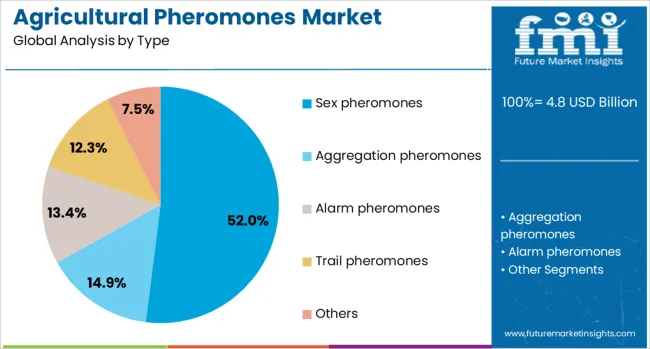
The sex pheromones segment is expected to hold 52% of the Agricultural Pheromones market revenue share in 2025, emerging as the leading product type. This segment's growth has been primarily supported by its effectiveness in targeting specific insect species through natural mating behavior disruption.
Demand has been driven by the ability of sex pheromones to offer a non-toxic, residue-free alternative to conventional pesticides, aligning well with organic farming and export-grade crop standards. Their high efficacy in pest population monitoring and control, along with reduced resistance development compared to synthetic chemicals, has reinforced adoption among growers.
Additionally, favorable regulatory acceptance and ease of deployment in various crop systems have promoted increased use. As agricultural sectors globally aim to reduce chemical load and enhance sustainability credentials, sex pheromones are being increasingly deployed to ensure crop protection while preserving ecological balance..
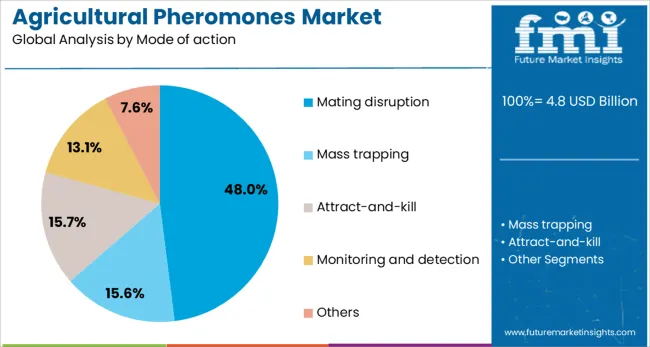
The mating disruption segment is projected to capture 48% of the Agricultural Pheromones market revenue share in 2025, making it the dominant mode of action. Growth of this segment has been attributed to its precision in interrupting pest reproduction cycles without killing the insects, which supports environmentally sound pest control.
Widespread implementation in high-value crops has been observed due to its long-lasting effect and minimal impact on beneficial insect populations. Mating disruption has also gained traction as it reduces the need for frequent pesticide applications, thereby decreasing labor and input costs for growers.
It has proven particularly useful in managing large-scale pest outbreaks in a controlled and cost-efficient manner. Support from agricultural extension programs and growing acceptance in regulatory frameworks have accelerated the integration of this method into mainstream integrated pest management programs across multiple regions..

The horticulture segment is anticipated to contribute 57% of the Agricultural Pheromones market revenue share in 2025, positioning it as the leading end-use category. The growth of this segment has been driven by the intensive pest pressure faced by fruits, vegetables, and ornamental crops, where even minimal infestations can result in substantial economic losses.
Adoption of pheromone-based pest control solutions in horticulture has been widespread due to their compatibility with residue-free production standards and export market requirements. Horticultural producers have increasingly favored pheromones to meet certifications for organic and sustainable farming, which has significantly contributed to this segment's expansion.
The segment’s growth has also been supported by high-value returns from horticultural produce, where investment in innovative pest management technologies is often justified. Continued focus on enhancing crop yield, quality, and sustainability in horticultural systems is expected to sustain the demand for pheromone-based solutions over the forecast period..
The agricultural pheromones market is expanding as farmers increasingly seek effective pest control solutions that reduce environmental impact. Pheromones, naturally occurring chemical substances used to influence pest behavior, are becoming a key component in integrated pest management (IPM) strategies. They disrupt mating cycles, prevent pest infestations, and reduce the need for chemical pesticides. As demand for organic farming practices rises, pheromones are gaining popularity in crop protection. Despite challenges such as high production costs and limited awareness, there are opportunities in developing new formulations and expanding adoption in emerging agricultural markets.
The agricultural pheromones market is largely driven by the growing demand for eco-friendly pest control methods. Traditional chemical pesticides have raised concerns regarding their environmental impact and harm to non-target species. As awareness of these issues increases, biological pest control methods, such as pheromones, are gaining traction. These naturally occurring substances target specific pests by disrupting their mating behavior, reducing reliance on broad-spectrum pesticides. This approach is gaining popularity in both organic farming and conventional agriculture, especially for crops such as fruits, vegetables, and grains. As farmers seek more efficient, selective pest control solutions, the adoption of pheromones is accelerating.
One of the main challenges in the agricultural pheromones market is the high cost of production. Manufacturing synthetic pheromones on a large scale requires significant investment, making them expensive compared to traditional pest control methods. This can be a barrier for smaller farms with limited budgets. Additionally, there is a lack of awareness among farmers about the benefits and proper application of pheromones. Pheromone-based pest control requires knowledge of local pest populations, timing, and specific application methods to be effective. Bridging the knowledge gap and reducing production costs are key to overcoming these challenges and increasing the market adoption of pheromones.
There are significant opportunities in the agricultural pheromones market driven by innovations in pheromone formulations and expanding market reach. Advances in pheromone chemistry, such as more stable, cost-effective, and easy-to-apply formulations, are opening new doors for wider adoption. The rising popularity of organic farming and eco-conscious agricultural practices in emerging markets like Asia-Pacific and Africa presents an untapped opportunity. As farmers in these regions face pressure to improve crop yields while minimizing environmental impact, the demand for precise and effective pest control solutions like pheromones is expected to grow, offering long-term growth prospects in these markets.
A significant trend in the agricultural pheromones market is the increasing integration of pheromone-based solutions into integrated pest management (IPM) systems. IPM combines biological, mechanical, cultural, and chemical methods to minimize pesticide use while maintaining crop productivity. The use of pheromones in these systems is growing due to their ability to target specific pests, reduce pest populations, and protect beneficial insects. As more farmers and agricultural businesses adopt IPM strategies, the demand for pheromones is rising. This trend reflects a shift toward more precise, efficient pest control methods that improve overall crop protection while minimizing environmental impact.
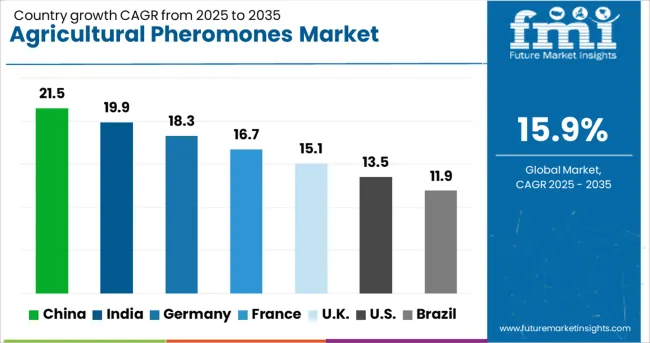
| Country | CAGR |
|---|---|
| China | 21.5% |
| India | 19.9% |
| Germany | 18.3% |
| France | 16.7% |
| UK | 15.1% |
| USA | 13.5% |
| Brazil | 11.9% |
The agricultural pheromones market is projected to grow at a global CAGR of 15.9% from 2025 to 2035. China leads the market at 21.5%, followed by India at 19.9%, and France at 16.7%. The United Kingdom is expected to grow at 15.1%, while the United States is projected to grow at 13.5%. The market growth in China and India is primarily driven by the increasing adoption of organic farming methods and growing demand for eco-friendly pest control solutions. In OECD countries like France, the UK, and the USA, steady growth is supported by rising awareness of sustainable farming practices and government initiatives to promote environmentally friendly pest management. The analysis spans 40+ countries, with the leading markets shown below.
China is set to grow at an impressive 21.5% CAGR, driven by its large agricultural sector and growing adoption of modern pest management techniques. As the world’s largest producer of various crops, China faces significant challenges with pest control, especially in rice, vegetables, and fruit farming. The government’s push to reduce pesticide use and enhance agricultural productivity is fostering the adoption of pheromones as an effective alternative. The shift towards using pheromones for pest control aligns with China’s broader goals to improve food safety and reduce environmental impact. With more farmers turning to pheromone-based solutions, the market is poised for continued expansion.
India is experiencing a 19.9% CAGR in the agricultural pheromones market, driven by its growing agricultural output and the need for alternative pest control methods. India faces challenges with pest resistance to traditional pesticides, prompting farmers to seek more targeted and efficient solutions. Pheromones are gaining popularity in crops like cotton, rice, and sugarcane, where pest issues are prevalent. The Indian government’s support for advanced farming techniques and pest management is contributing to the growth of this market. The increasing awareness of pheromones as a safer and more effective pest control option is further accelerating their adoption across the country.
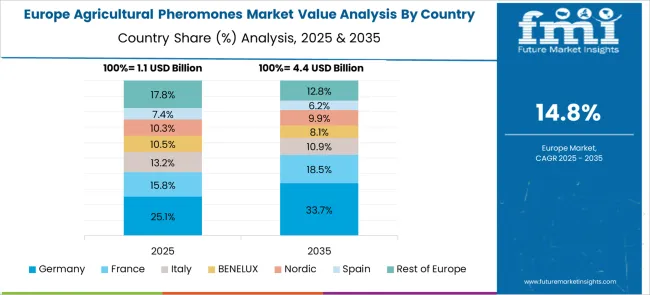
The agricultural pheromones market in France is projected to grow at 16.7%, driven by the country’s emphasis on improving crop yields while reducing chemical pesticide usage. French farmers are increasingly turning to biological pest control methods, including pheromones, as part of integrated pest management (IPM) systems. France’s agricultural landscape, which includes a wide range of crops like vineyards, orchards, and grains, benefits from pheromone solutions due to their precision in targeting specific pests. Government regulations and policies promoting less chemical pesticide use and supporting biological control solutions contribute to the growing adoption of pheromone-based pest management in the country.
Demand for agricultural pheromones in the United Kingdom is expanding at a 15.1% CAGR, driven by the growing need for efficient pest management in its agricultural sector. The UK’s focus on reducing chemical pesticide use and promoting alternative pest control methods is increasing the adoption of pheromones, particularly in crop production and horticulture. The government’s push for reduced chemical reliance and the growing demand for organic food are factors accelerating market growth. Pheromones are seen as a viable solution to protect crops from pests while meeting the increasing consumer demand for chemical-free produce. This trend is expected to continue as more farmers adopt pheromone-based solutions.
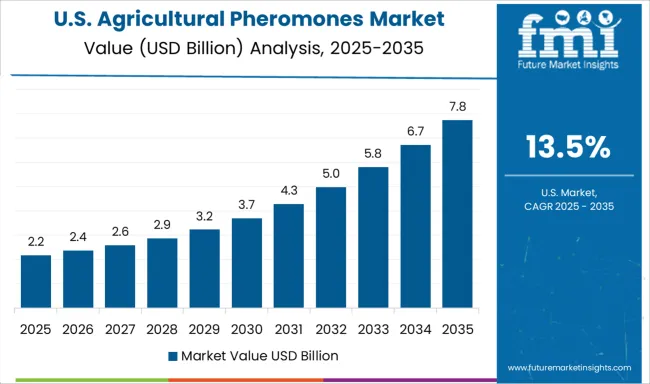
The USA agricultural pheromones market is expected to grow at a 13.5% CAGR, driven by the growing demand for targeted pest control solutions. The country’s vast agricultural industry, which includes crops like corn, soybeans, and fruits, faces challenges with traditional pesticide methods, including resistance and environmental concerns. As a result, pheromones are being increasingly integrated into pest management strategies. USA farmers are adopting pheromones for their precision and minimal impact on non-target species. The growing preference for eco-friendly food products and government incentives to support alternative pest control methods further contribute to the growth of the agricultural pheromones market in the USA
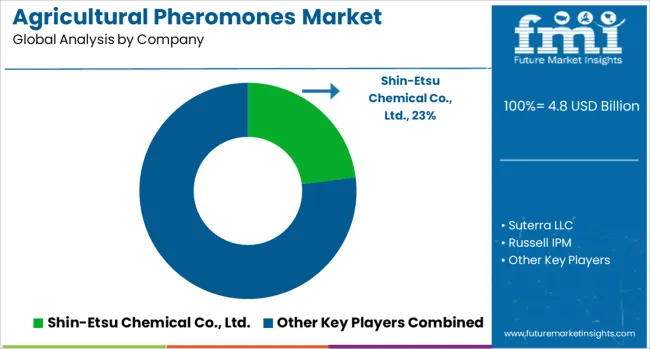
The agricultural pheromones market is driven by key players offering environmentally friendly pest control solutions that reduce the reliance on chemical pesticides. Shin-Etsu Chemical Co., Ltd. is a leading player, providing high-quality synthetic pheromone products for pest management, focusing on precision and effectiveness in pest population control. Suterra LLC specializes in sustainable pest management using pheromone-based products designed to protect crops such as fruit, vegetables, and grains from insect damage, offering a natural alternative to conventional pesticides. Russell IPM is a key competitor, providing integrated pest management solutions through a range of pheromone products, which are widely used in organic farming and by growers seeking eco-friendly solutions.
ISCA Technologies focuses on developing advanced pheromone systems that target specific pests, aiming to disrupt mating and reduce pest populations with minimal environmental impact. Provivi is an emerging player in the market, leveraging innovative technologies to produce cost-effective and highly targeted pheromone solutions for pest control, particularly in large-scale agricultural applications. Competitive differentiation in this market is driven by product effectiveness, environmental safety, cost efficiency, and the ability to provide tailored solutions for specific pest species. Barriers to entry include high R&D costs, regulatory hurdles, and the need for continuous innovation. Strategic priorities include developing pheromone-based products with improved performance, expanding product offerings to cover more pest species, and reducing costs to make pheromone-based solutions more accessible to farmers worldwide.
The global agricultural pheromones market is estimated to be valued at USD 4.8 billion in 2025.
The market size for the agricultural pheromones market is projected to reach USD 20.8 billion by 2035.
The agricultural pheromones market is expected to grow at a 15.9% CAGR between 2025 and 2035.
The key product types in agricultural pheromones market are sex pheromones, aggregation pheromones, alarm pheromones, trail pheromones and others.
In terms of mode of action, mating disruption segment to command 48.0% share in the agricultural pheromones market in 2025.






Our Research Products

The "Full Research Suite" delivers actionable market intel, deep dives on markets or technologies, so clients act faster, cut risk, and unlock growth.

The Leaderboard benchmarks and ranks top vendors, classifying them as Established Leaders, Leading Challengers, or Disruptors & Challengers.

Locates where complements amplify value and substitutes erode it, forecasting net impact by horizon

We deliver granular, decision-grade intel: market sizing, 5-year forecasts, pricing, adoption, usage, revenue, and operational KPIs—plus competitor tracking, regulation, and value chains—across 60 countries broadly.

Spot the shifts before they hit your P&L. We track inflection points, adoption curves, pricing moves, and ecosystem plays to show where demand is heading, why it is changing, and what to do next across high-growth markets and disruptive tech

Real-time reads of user behavior. We track shifting priorities, perceptions of today’s and next-gen services, and provider experience, then pace how fast tech moves from trial to adoption, blending buyer, consumer, and channel inputs with social signals (#WhySwitch, #UX).

Partner with our analyst team to build a custom report designed around your business priorities. From analysing market trends to assessing competitors or crafting bespoke datasets, we tailor insights to your needs.
Supplier Intelligence
Discovery & Profiling
Capacity & Footprint
Performance & Risk
Compliance & Governance
Commercial Readiness
Who Supplies Whom
Scorecards & Shortlists
Playbooks & Docs
Category Intelligence
Definition & Scope
Demand & Use Cases
Cost Drivers
Market Structure
Supply Chain Map
Trade & Policy
Operating Norms
Deliverables
Buyer Intelligence
Account Basics
Spend & Scope
Procurement Model
Vendor Requirements
Terms & Policies
Entry Strategy
Pain Points & Triggers
Outputs
Pricing Analysis
Benchmarks
Trends
Should-Cost
Indexation
Landed Cost
Commercial Terms
Deliverables
Brand Analysis
Positioning & Value Prop
Share & Presence
Customer Evidence
Go-to-Market
Digital & Reputation
Compliance & Trust
KPIs & Gaps
Outputs
Full Research Suite comprises of:
Market outlook & trends analysis
Interviews & case studies
Strategic recommendations
Vendor profiles & capabilities analysis
5-year forecasts
8 regions and 60+ country-level data splits
Market segment data splits
12 months of continuous data updates
DELIVERED AS:
PDF EXCEL ONLINE
Agricultural Multifunction Grab Bucket Market Size and Share Forecast Outlook 2025 to 2035
Agricultural Bucket Market Size and Share Forecast Outlook 2025 to 2035
Agricultural Lighting Market Forecast and Outlook 2025 to 2035
Agricultural Sprayers Market Size and Share Forecast Outlook 2025 to 2035
Agricultural Fumigant Market Size and Share Forecast Outlook 2025 to 2035
Agricultural Coatings Market Size and Share Forecast Outlook 2025 to 2035
Agricultural Secondary Nutrients Market Size and Share Forecast Outlook 2025 to 2035
Agricultural Chelates Market Size and Share Forecast Outlook 2025 to 2035
Agricultural Tractors Market Analysis - Size, Share, and Forecast Outlook 2025 to 2035
Agricultural Tires Market Analysis - Size, Share, and Forecast Outlook 2025 to 2035
Agricultural Adjuvant Market - Size, Share, and Forecast Outlook 2025 to 2035
Agricultural Microbials Market Size and Share Forecast Outlook 2025 to 2035
Agricultural Gloves Market Size and Share Forecast Outlook 2025 to 2035
Agricultural Activator Adjuvant Market Analysis - Size, Share, and Forecast Outlook 2025 to 2035
Agricultural Surfactants Market Analysis – Size, Share, and Forecast Outlook 2025 to 2035
Agricultural Testing Services Market Growth - Trends & Forecast 2025 to 2035
Agricultural Mapping Services Market Growth - Trends & Forecast 2025 to 2035
Agricultural Grade Zinc Chemicals Market Growth - Trends & Forecast 2025 to 2035
Agricultural Fabrics Market Growth - Trends & Forecast 2025 to 2035
Agricultural Food Grade Rubber Conveyor Belt Market Growth - Trends & Forecast 2025 to 2035

Thank you!
You will receive an email from our Business Development Manager. Please be sure to check your SPAM/JUNK folder too.
Chat With
MaRIA